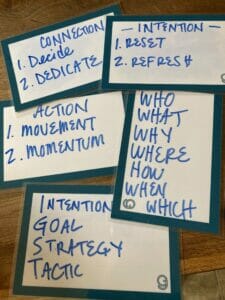If you’re wondering or struggling with effective presentations in a highly virtual world, here’s a list of professional recommendations a course organizer recently asked me for (after I audited a few of their classes).
1. Having the team take courses on how to effectively present, both in-person and virtually, would be wise.
2. The tempo of effective screen learning, just as in person, requires an elevated level of positive energy. The meetings, while full of good people, are not energetically positive; I leave feeling drained, not amped up. No matter the topic, the energy delivered by the presenters must be positive to be effective.
3. Technical set up: the best presenters stand – it’s a whole different realm of teaching. And I bet we all can recall a teacher in our growing up who sat the whole time – how’d that feel and how effective was that? How about that ‘great teacher’ who stood, moved around, bantered, and interacted – sometimes very animatedly – to robust success?
4. Lighting & all things set up: if you want to deliver world-class education, you must set up in a world-class fashion; test & check; fine tune – recheck and adjust.
Get people out of your background; this is legit professional teaching – the students deserve to feel they are the sole focus. People coming and going behind presenters is distracting and lowers the level of professionalism and therefore the perception and engagement of the audience. The tone is set by the teachers. They must model what they want in the students.

5. I’d cut out 3/4 of your material. It’s too dense; the charts and graphs aren’t overly effective in person – don’t drown the audience with them virtually either. I’ve never had an audience member ask for slides. Share a pdf in advance or offer a review or resource sheet sent afterwards. The more people are actively responsible for their learning, the more they’ll participate.
6. Add a lot more activity. Use props to hold up; ask people to bring props – i.e. noise or music makers, for example.
7. Hire a professional presenter to teach, one who has done what you want with robust success many times over. The idea of paying someone is a mental roadblock for most people; making the investment is necessary if you want to create a program of lasting worth, meaning and impact.
A mentality of abundance is required. The mentality of lack is a killer, for everyone – “we can’t afford it,” or “we’re a non-profit” [which is still a business that needs to make money to survive and grow]). WHO would be interested in presenting for us, who would deliver what we’re seeking to teach effectively, enthusiastically, well-versed? Find out who that person is, tell them your vision, find out what their fees are; figure out how to make it work.
For the speaking profession, honorariums are still better to offer than nothing. And rest assured that promising ‘exposure’ is not enticing for pros; exposure gives you frostbite or sunburn. Win win happens when all parties have skin in the game.
